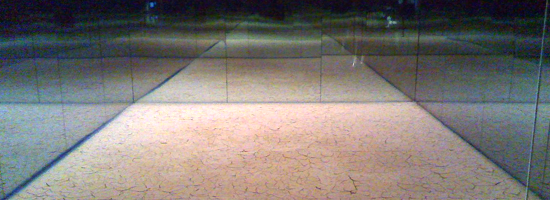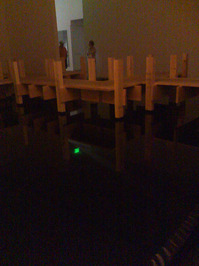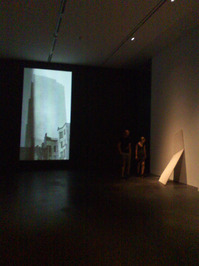Museum of Contemporary Art Denver: Another Victory Over the Sun
June 9, 2011 - August 21, 2011
 Learning to step into the shade was my first victory over the sun. Is this show about how man's ingenuity can beat nature's unpleasantness? Or do we need to know the art history themes attributed to the first Victory Over the Sun to get this show?
Learning to step into the shade was my first victory over the sun. Is this show about how man's ingenuity can beat nature's unpleasantness? Or do we need to know the art history themes attributed to the first Victory Over the Sun to get this show?
Victory Over the Sun is the title of a 1913 opera produced by Russians called Youth Group. They included adults as old as 50 so this was no camp project but an assertion of their own importance from a new group of 'emerging' artists - poets who wrote the libretto in Zaum, a language developed from the emotional and instinctual quality of sounds - and artists, including Kazimir Malevich, who is often credited with making the first abstract painting. A reproduction of this Victory, made by the California Institute of the Arts, plays in the elevator, if you wish to watch it. The opera, Internet research points out to me, claimed to vanquish the 'sun,' a symbol for the previous generation of artists, called the Symbolists, rational, intellectual, nature lovers. The new school victors' were right to gloat because their thinking did predominate art for the next twenty years, evolving into, generally, surrealism. These artists made paintings and poetry with whatever came out of their heads. Natural man triumphs over the sun and rationality.
The show directs us to this opera as a source, and then does some of its own battling with the sun. For Another Victory Over the Sun museum staffers blocked out all natural light. This building is no windowless schoolhouse, but a green building that uses natural light for most of its daytime illumination and the effect is noticeable. The entry is lit by a Dan Flavin piece called Monument to V. Tatlin. Tatlin was another Russian artist from the early 20th century. Anyone standing near the piece glows fluorescent.
The other works in the show produce their own light, too, and it helps to illustrate the exhibition notes that claim art can create a reality more intense than its architecture. Art is like a campfire, we're told, it is more than its logs and twigs.
Man over Nature, New over Old, Emotion/Instinct/Feeling over Rational Intellect, Art over Tangibles.: that's our list of given possible themes.
 Many of the pieces in this show offer experiences that are more than the sum of its parts, and yes, they are emotive, and about nature, and all done in this millennium. We can feel the snarls of a panther in the dark, glow with the moon over water, play with mirrors in an overgrown castle, speed up the transit of the sun, imagine infinity, contemplate the twitter of birds, and graph the sway of trees.
Many of the pieces in this show offer experiences that are more than the sum of its parts, and yes, they are emotive, and about nature, and all done in this millennium. We can feel the snarls of a panther in the dark, glow with the moon over water, play with mirrors in an overgrown castle, speed up the transit of the sun, imagine infinity, contemplate the twitter of birds, and graph the sway of trees.
Yes, I learned about emotional vs. rational art appreciation. Yesterday, I visited the museum with a friend who believes the sensory/instinctual human has power over the rational. She believes that a guru gazing on her will heal her body. (She's also using everything Western Medicine has to offer for her cancer.)
We walked into the gallery with the piece called Between the Moon and Sea. It is a wooden boardwalk built over a room-encompassing, black plastic pool of water illuminated by a beach-ball-size, cloth-covered lamp. "This must be a come-down for someone who has lived in the mountains for so long," I said to my friend, thinking of my experience of back-county moonlight ski trips as a much bigger, heart-thumbing, cold--and-hot-at-the-same-time kind of experience. She completely disagreed. She loves the piece. It makes her think of everything she loves about nature -- and more, and more. I slow down and stop trying to rationalize if this piece works, and take a photo of the EXIT sign reflected in the water. You may listen to us talk about the entire Another Victory over the Sun exhibition, if you'd like.
She and I are predisposed to give art the benefit of the doubt. Many of my environmentalist friends are not. They see art as just another commercialism of man's intention to triumph over nature. And they want nature to win. They are certain than nature will not go down easily, and if it does, it will take us humans with it.
Contemporary art's urban emphasis is somewhat the cause of my enviro friends' distaste. Land art was only big when it was about machines tearing up nature and making things like the Spiral Jetty. Present-day land artists like Andy Goldsworthy, seem somewhat parochial, while graffiti gets attention. Publicized contemporary art is often messy and about shit and self-inflicted violence or rooms that remind me of bad roommates. Rarely does it talk about the concerns of the environmentalist. But this Victory does. Although I'm not sure the environmentalist or the curators know it.
The experiences in this MCA exhibition are as powerful as my friend said, unless I analyze them to death. When I experience Los Pasos del Enemigo, The Steps of the Enemy, panthers are, I am reminded, amazing. They make sounds and behave in ways that people living in a city forget. I don't want them to disappear even if they are scary. Everyone wants the opportunity to contemplate the moon in a quiet, under-developed place. We like the quiet and peace of undisturbed land, even if the birds are so loud. We like the sun, actually.
 In the upstairs galleries are three different artist installations that show at least four more instances of the wonder of everyday nature. Outside the gallery showing trees in a breeze and bird's on a branch, the curatorial notes tell us David Zimmer's work shows the 'enigmatic in the everyday.' That's a nice phrase for the puzzles that nature provides all the time. And art can make vivid.
In the upstairs galleries are three different artist installations that show at least four more instances of the wonder of everyday nature. Outside the gallery showing trees in a breeze and bird's on a branch, the curatorial notes tell us David Zimmer's work shows the 'enigmatic in the everyday.' That's a nice phrase for the puzzles that nature provides all the time. And art can make vivid.
Another makes me think about how the sun's daily journey changes how I see object on the planet and on my desk. The third gives me a mirror view tour of a Mexican villa over grown by nature.
Most of the work in this show does create new realities. For me, the reality I came away with is that contemporary art doesn't need to be messy, necessarily urban, self-expressive, but should be clear. Sometime the clarity can only but felt. Sometimes the enigmas are not understandable. Not at the moment; but art gives me the hope that they can be.
June 9, 2011 - August 21, 2011
 Learning to step into the shade was my first victory over the sun. Is this show about how man's ingenuity can beat nature's unpleasantness? Or do we need to know the art history themes attributed to the first Victory Over the Sun to get this show?
Learning to step into the shade was my first victory over the sun. Is this show about how man's ingenuity can beat nature's unpleasantness? Or do we need to know the art history themes attributed to the first Victory Over the Sun to get this show?Victory Over the Sun is the title of a 1913 opera produced by Russians called Youth Group. They included adults as old as 50 so this was no camp project but an assertion of their own importance from a new group of 'emerging' artists - poets who wrote the libretto in Zaum, a language developed from the emotional and instinctual quality of sounds - and artists, including Kazimir Malevich, who is often credited with making the first abstract painting. A reproduction of this Victory, made by the California Institute of the Arts, plays in the elevator, if you wish to watch it. The opera, Internet research points out to me, claimed to vanquish the 'sun,' a symbol for the previous generation of artists, called the Symbolists, rational, intellectual, nature lovers. The new school victors' were right to gloat because their thinking did predominate art for the next twenty years, evolving into, generally, surrealism. These artists made paintings and poetry with whatever came out of their heads. Natural man triumphs over the sun and rationality.
The show directs us to this opera as a source, and then does some of its own battling with the sun. For Another Victory Over the Sun museum staffers blocked out all natural light. This building is no windowless schoolhouse, but a green building that uses natural light for most of its daytime illumination and the effect is noticeable. The entry is lit by a Dan Flavin piece called Monument to V. Tatlin. Tatlin was another Russian artist from the early 20th century. Anyone standing near the piece glows fluorescent.
The other works in the show produce their own light, too, and it helps to illustrate the exhibition notes that claim art can create a reality more intense than its architecture. Art is like a campfire, we're told, it is more than its logs and twigs.
Man over Nature, New over Old, Emotion/Instinct/Feeling over Rational Intellect, Art over Tangibles.: that's our list of given possible themes.
 Many of the pieces in this show offer experiences that are more than the sum of its parts, and yes, they are emotive, and about nature, and all done in this millennium. We can feel the snarls of a panther in the dark, glow with the moon over water, play with mirrors in an overgrown castle, speed up the transit of the sun, imagine infinity, contemplate the twitter of birds, and graph the sway of trees.
Many of the pieces in this show offer experiences that are more than the sum of its parts, and yes, they are emotive, and about nature, and all done in this millennium. We can feel the snarls of a panther in the dark, glow with the moon over water, play with mirrors in an overgrown castle, speed up the transit of the sun, imagine infinity, contemplate the twitter of birds, and graph the sway of trees. Yes, I learned about emotional vs. rational art appreciation. Yesterday, I visited the museum with a friend who believes the sensory/instinctual human has power over the rational. She believes that a guru gazing on her will heal her body. (She's also using everything Western Medicine has to offer for her cancer.)
We walked into the gallery with the piece called Between the Moon and Sea. It is a wooden boardwalk built over a room-encompassing, black plastic pool of water illuminated by a beach-ball-size, cloth-covered lamp. "This must be a come-down for someone who has lived in the mountains for so long," I said to my friend, thinking of my experience of back-county moonlight ski trips as a much bigger, heart-thumbing, cold--and-hot-at-the-same-time kind of experience. She completely disagreed. She loves the piece. It makes her think of everything she loves about nature -- and more, and more. I slow down and stop trying to rationalize if this piece works, and take a photo of the EXIT sign reflected in the water. You may listen to us talk about the entire Another Victory over the Sun exhibition, if you'd like.
She and I are predisposed to give art the benefit of the doubt. Many of my environmentalist friends are not. They see art as just another commercialism of man's intention to triumph over nature. And they want nature to win. They are certain than nature will not go down easily, and if it does, it will take us humans with it.
Contemporary art's urban emphasis is somewhat the cause of my enviro friends' distaste. Land art was only big when it was about machines tearing up nature and making things like the Spiral Jetty. Present-day land artists like Andy Goldsworthy, seem somewhat parochial, while graffiti gets attention. Publicized contemporary art is often messy and about shit and self-inflicted violence or rooms that remind me of bad roommates. Rarely does it talk about the concerns of the environmentalist. But this Victory does. Although I'm not sure the environmentalist or the curators know it.
The experiences in this MCA exhibition are as powerful as my friend said, unless I analyze them to death. When I experience Los Pasos del Enemigo, The Steps of the Enemy, panthers are, I am reminded, amazing. They make sounds and behave in ways that people living in a city forget. I don't want them to disappear even if they are scary. Everyone wants the opportunity to contemplate the moon in a quiet, under-developed place. We like the quiet and peace of undisturbed land, even if the birds are so loud. We like the sun, actually.
 In the upstairs galleries are three different artist installations that show at least four more instances of the wonder of everyday nature. Outside the gallery showing trees in a breeze and bird's on a branch, the curatorial notes tell us David Zimmer's work shows the 'enigmatic in the everyday.' That's a nice phrase for the puzzles that nature provides all the time. And art can make vivid.
In the upstairs galleries are three different artist installations that show at least four more instances of the wonder of everyday nature. Outside the gallery showing trees in a breeze and bird's on a branch, the curatorial notes tell us David Zimmer's work shows the 'enigmatic in the everyday.' That's a nice phrase for the puzzles that nature provides all the time. And art can make vivid. Another makes me think about how the sun's daily journey changes how I see object on the planet and on my desk. The third gives me a mirror view tour of a Mexican villa over grown by nature.
Most of the work in this show does create new realities. For me, the reality I came away with is that contemporary art doesn't need to be messy, necessarily urban, self-expressive, but should be clear. Sometime the clarity can only but felt. Sometimes the enigmas are not understandable. Not at the moment; but art gives me the hope that they can be.